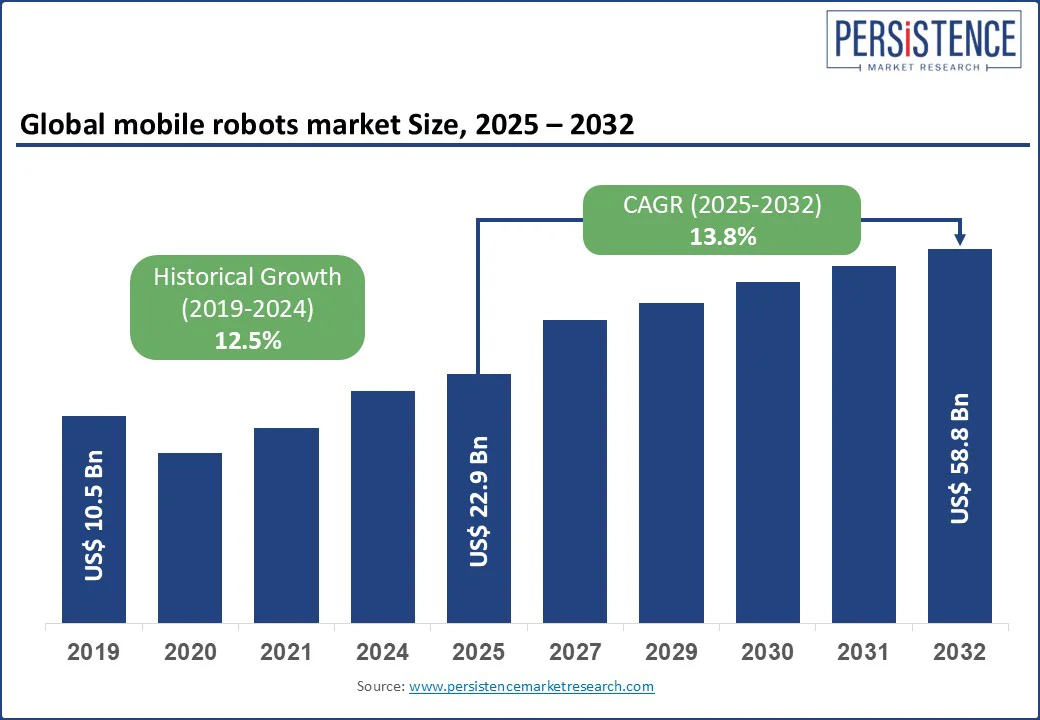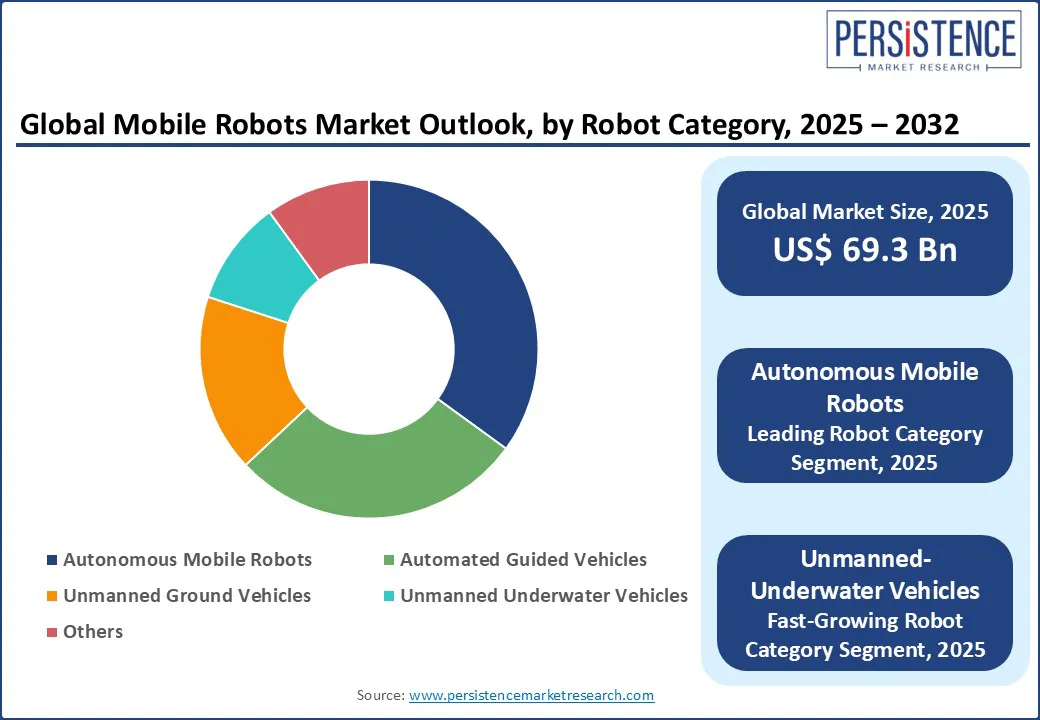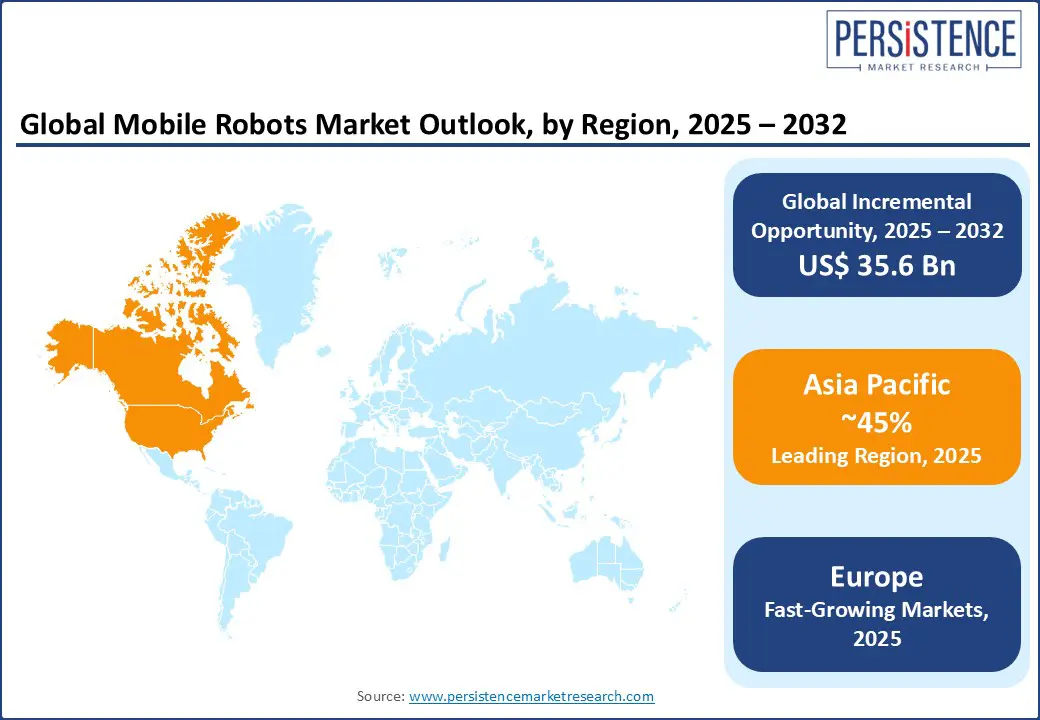ID: PMRREP35519| 197 Pages | 28 Jul 2025 | Format: PDF, Excel, PPT* | Industrial Automation

The global mobile robot market size is projected to rise from US$ 22.9 Bn in 2025 to US$ 58.6 Bn by 2032. It is anticipated to witness a CAGR of 13.8% during the forecast period from 2025 to 2032. The mobile robot market growth is driven by rise in automation in many industries, labor shortages during the pandemic, and advancements in AI, sensor technology, and navigation systems. These robots offer flexibility, cost savings, and improved efficiency across various sectors. For example, in warehouses, mobile robots improve inventory management and order fulfillment, while in healthcare, they support disinfection, deliveries, and patient care, improving safety and operations.

Key Industry Highlights:
| Global Market Attribute | Key Insights |
| Mobile Robot Size (2025E) | US$ 22.9 Bn |
| Market Value Forecast (2032F) | US$ 58.6 Bn |
| Projected Growth (CAGR 2025 to 2032) | 13.8% |
| Historical Market Growth (CAGR 2019 to 2024) | 12.5% |
In hospitals, mobile robots are increasingly being deployed to transport medical supplies, equipment, and medications, helping to streamline operations and reduce the workload on clinical staff. For instance, in 2025, Taichung Veterans General Hospital deployed NVIDIA’s Nurabot to deliver medications and monitor patient vitals, allowing nurses to focus more on direct patient care.
Similarly, in agriculture, autonomous robots are used for tasks such as planting, harvesting, and crop monitoring, addressing labor shortages and improving productivity. According to a 2024 report by the International Federation of Robotics (IFR), global sales of agricultural robots experienced a 21% growth, with nearly 20,000 units sold in 2023, highlighting the rapid adoption of mobile robots.
These developments indicate the potential for mobile robots to transform operational workflows across industries. Government-backed programs, such as the U.K.’s NHS trials of autonomous ground delivery robots in London in 2025, will further accelerate adoption.
Mobile robots such as autonomous mobile robots (AMRs), automated guided vehicles (AGVs), and service robots rely extensively on battery power for navigation, task execution, and continuous operation in fast-paced environments such as warehouses, hospitals, and manufacturing units. Limited battery life often results in frequent recharging or battery swapping, which leads to operational downtime, reduced productivity, and increased costs.
In warehouse operations, for example, AMRs and AGVs typically spend 15-20% of each day charging, causing 3.6 to 4.8 hours of daily downtime, even under efficient charging setups. To offset this loss, facilities are often required to procure 20-35% more robots than needed, adding to capital expenditures. Additionally, charging infrastructure can consume 150 to 250 square feet per station, reducing valuable floor space that could otherwise be used for storage or goods movement. These operational and spatial inefficiencies significantly challenge the cost-effectiveness and scalability of mobile robot deployments.
RaaS transforms robots from capital-intensive assets into on-demand operational tools, allowing businesses to lease or subscribe to fleets of autonomous mobile robots (AMRs) and other robotic systems. This shift democratizes access to automation, particularly for small and medium-sized enterprises, by lowering financial and technical barriers. In the warehousing and logistics sector, RaaS adoption is accelerating due to persistent labor shortages and e-commerce surges, where businesses need scalable, flexible solutions during peak demand cycles.
For instance, Locus’s Robots-as-a-Service (RaaS) model enables warehouses to rapidly deploy autonomous mobile robots (AMRs) with minimal upfront investment. By shifting robotics to an operational expense, Locus shortens ROI from years to months and eliminates maintenance overhead. Their model offers seamless scalability; businesses can add or remove robots based on demand fluctuations, making automation highly adaptable.
Mobile manipulators, robots that combine autonomous mobility with robotic arms, are rapidly evolving from research prototypes to practical tools in industrial and commercial environments. This is being driven by the surge in e-commerce activity and the growing need for robotic systems that can not only transport goods but also manipulate them, such as picking, placing, or handling heavy items. Advances in R&D have significantly improved the capabilities and reliability of these systems, making them viable for deployment in real-world scenarios.
In 2024, Robotnik, a European mobile-robotics market player, introduced RB-ROBOUT+, an autonomous mobile manipulator with a 20 kg payload arm for heavy-duty handling applications in manufacturing or tool operation. Similarly, Dexterity Inc. launched in March 2025 a multi-arm mobile manipulator for truck loading operations, confirming the move toward physically AI-controlled mobile heavy manipulators.
Based on robot category, the segmentation includes autonomous mobile robots, automated guided vehicles, unmanned ground vehicles, unmanned underwater vehicles, and others. Among these, autonomous mobile robots (AMRs) are projected to account for approximately 30% of the market share in 2025, due to their flexibility, adaptability, and growing use across multiple industries. AMRs move through changing environments without predetermined paths and are best suited for complex warehouse, logistics, and manufacturing processes.
For instance, Amazon uses over 750,000 robots in its fulfillment centers as of 2024; the AMRs within Amazon fulfillment centers effectively reduced order fulfillment expenses by 25% and should reach a US$ 10 Bn annual savings target until 2030.
Unmanned ground vehicles (UGVs) are witnessing growing adoption due to their capability to operate in hazardous or high-risk environments without direct human control. Military and defense applications continued to be a major driver, with increasing demand for robotic platforms capable of surveillance, reconnaissance, explosive ordnance disposal, and logistics in conflict zones. For instance, the U.S. Army’s Robotic Combat Vehicle (RCV) program and India’s push for AI-enabled unmanned ground systems under its ‘Make in India’ initiative have accelerated growth in this segment.
Based on automation level, the market is segmented into fully autonomous, semi-autonomous, and remotely operated. Among these, fully autonomous is estimated to account for approximately 40% of market share, primarily driven by rapid advancements in AI, machine learning, and sensor technologies. These robots can navigate complex environments, make real-time decisions, and operate with minimal human intervention, increasing efficiency and reducing labor costs. In healthcare, fully autonomous robots such as Aethon’s TUG deliver medications and supplies without manual assistance, enhancing hospital workflows. The rise of Industry 4.0 and smart factories further accelerates demand as fully autonomous robots seamlessly integrate into automated production lines.
Semi-autonomous mobile robots are also growing at a significant rate during the forecast period, as these robots combine human input with automated functions, making them particularly suitable for industries transitioning from manual operations to full automation. For example, semi-autonomous robots are widely used in warehouses for picking and sorting tasks, where workers collaborate with robots to boost throughput while retaining control over complex decisions.

Asia Pacific dominates the market with approximately 45% of market share due to the high concentration of top electronics and automotive companies, which has generated high levels of demand for mobile robots used in production processes. For instance, China reached a robot density of 470 units per 10,000 manufacturing employees in 2023 (from hardly any beyond the leaders in the top 10 in 2019). South Korea is in the lead worldwide, attaining a density of 1,012 robots per 10,000 workers, which is over twice the level of any nation but Singapore.
The dominance of the region is also boosted by R&D investments made by governments in countries such as China, Japan, South Korea and Singapore. For example, China's Key Special Program on Intelligent Robots has received approximately US$ 45 Mn in investment in 2024 under its overall 14th Five-Year Plan, reported by the International Federation of Robotics (IFR). South Korea's 4th Basic Plan on Intelligent Robots, initiated in January 2024, involves US$ 128 Mn in investment by 2028. As a major producer and consumer of robots, Japan has also launched strategic programs such as the New Robot Strategy, which aims to position the nation as the world's best robot innovation center.
North America is emerging as a global leader in the mobile robot market, driven by strong industrial integration, technological advancements, and favorable economic conditions. In Q3 2024, robot sales in the region surged by 8.8% year-over-year, reaching 7,329 units worth US$ 475 Mn. While the automotive industry continues to dominate with nearly half of these purchases, there is a rapid uptick in adoption across warehousing, distribution, and healthcare sectors.
This growth is further supported by government-led initiatives, including federal R&D funding, STEM workforce development, and collaborative public-private partnerships. These efforts foster a supportive innovation environment, enabling North America to sustain its leadership in mobile robotics. The combination of rising cross-sector demand, cutting-edge technology, and proactive policy measures positions the region at the forefront of global market expansion in 2025.
Europe is witnessing robust growth in the mobile robot market, driven by high industrial demand, dense automation, and supportive government initiatives. In 2023, the region accounted for 17% of global industrial robot installations, reaching nearly 92,400 units. Germany led with over 28,300 installations, around 38% of Europe's total, highlighting its dominant role in advanced manufacturing automation.
The adoption of mobile and service robots is expanding rapidly across logistics, healthcare, and infrastructure sectors, with around 33,918 professional service robots sold in 2023. Europe’s strategic emphasis on robotics is evident in its high robot densities, surpassing 200 units per 10,000 workers in many countries, with Germany ranking fourth globally at 429 units. Continued R&D investments further the position of Europe as a key hub for mobile robotics innovation.

The mobile robot market is highly fragmented, featuring both global giants such as Boston Dynamics, KUKA, and ABB, and fast-growing niche players such as Locus Robotics, Geek+, and Clearpath. These companies are increasingly forming partnerships with logistics, healthcare, and pharma sectors to tailor solutions for specific applications and compliance needs. For instance, in March 2025, Mobile Industrial Robots (MiR) launched a VDA 5050 Adapter to boost interoperability across mixed robot fleets, enhancing integration and efficiency in industrial settings.
The global mobile robot market is projected to be valued at US$ 22.9 Bn in 2025.
Businesses are seeking cost-effective alternatives to manual labor, especially for repetitive, dangerous, or labor-intensive tasks, which drive the demand for mobile robots.
The mobile robot market is poised to witness a CAGR of 13.8% from 2025 to 2032.
The growth of e-commerce and increasing demand for last-mile delivery automation are creating significant opportunities in the mobile robot market.
KUKA AG, ABB Ltd, Omron Corporation, Mobile Industrial Robots, Boston Dynamics, Clearpath Robotics, FANUC Corporation are among the leading key players.
| Report Attribute | Details |
| Historical Data/Actuals | 2019 - 2024 |
| Forecast Period | 2025 - 2032 |
| Market Analysis | Value: US$ Bn |
| Geographical Coverage |
|
| Segmental Coverage |
|
| Competitive Analysis |
|
| Report Highlights |
|
| Customization and Pricing | Available upon request |
By Robot Category
By Automation Level
By Application
By Region
Delivery Timelines
For more information on this report and its delivery timelines please get in touch with our sales team.
About Author